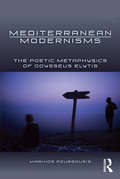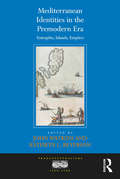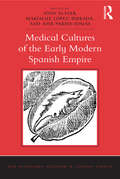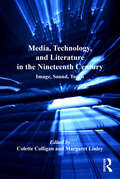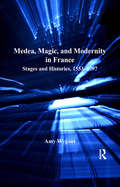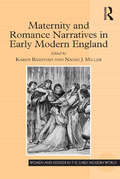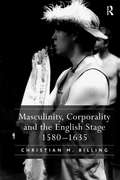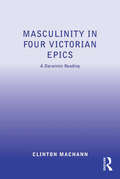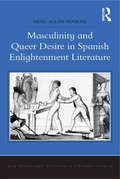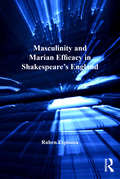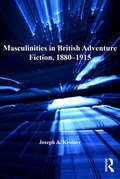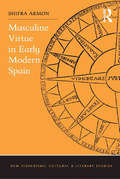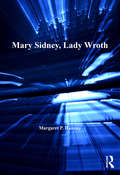- Table View
- List View
Mediterranean Modernisms: The Poetic Metaphysics of Odysseus Elytis
by Marinos PourgourisEngaging with the work of Nobel Prize-winning poet Odysseus Elytis within the framework of international modernism, Marinos Pourgouris places the poet's work in the context of other modernist and surrealist writers in Europe. At the same time, Pourgouris puts forward a redefinition of European Modernism that makes the Mediterranean, and Greece in particular, the discursive contact zone and incorporates neglected elements such as national identity and geography. Beginning with an examination of Greek Modernism, Pourgouris's study places Elytis in conversation with Albert Camus; analyzes the influence of Charles Baudelaire, Gaston Bachelard, and Sigmund Freud on Elytis's theory of analogies; traces the symbol of the sun in Elytis's poetry by way of the philosophies of Heraclitus and Plotinus; examines the influence of Le Corbusier on Elytis's theory of architectural poetics; and takes up the subject of Elytis's application of his theory of Solar Metaphysics to poetic form in the context of works by Freud, C. G. Jung, and Michel Foucault. Informed by extensive research in the United States and Europe, Pourgouris's study makes a compelling contribution to the comparative study of Greek modernism, the Mediterranean, and the work of Odysseus Elytis.
Mediterranean Modernisms: The Poetic Metaphysics of Odysseus Elytis
by Marinos PourgourisEngaging with the work of Nobel Prize-winning poet Odysseus Elytis within the framework of international modernism, Marinos Pourgouris places the poet's work in the context of other modernist and surrealist writers in Europe. At the same time, Pourgouris puts forward a redefinition of European Modernism that makes the Mediterranean, and Greece in particular, the discursive contact zone and incorporates neglected elements such as national identity and geography. Beginning with an examination of Greek Modernism, Pourgouris's study places Elytis in conversation with Albert Camus; analyzes the influence of Charles Baudelaire, Gaston Bachelard, and Sigmund Freud on Elytis's theory of analogies; traces the symbol of the sun in Elytis's poetry by way of the philosophies of Heraclitus and Plotinus; examines the influence of Le Corbusier on Elytis's theory of architectural poetics; and takes up the subject of Elytis's application of his theory of Solar Metaphysics to poetic form in the context of works by Freud, C. G. Jung, and Michel Foucault. Informed by extensive research in the United States and Europe, Pourgouris's study makes a compelling contribution to the comparative study of Greek modernism, the Mediterranean, and the work of Odysseus Elytis.
Mediterranean Identities in the Premodern Era: Entrepôts, Islands, Empires (Transculturalisms, 1400-1700)
by John Watkins Kathryn L. ReyersonThe first full length volume to approach the premodern Mediterranean from a fully interdisciplinary perspective, this collection defines the Mediterranean as a coherent region with distinct patterns of social, political, and cultural exchange. The essays explore the production, modification, and circulation of identities based on religion, ethnicity, profession, gender, and status as free or slave within three distinctive Mediterranean geographies: islands, entrepôts and empires. Individual essays explore such topics as interreligious conflict and accommodation; immigration and diaspora; polylingualism; classical imitation and canon formation; traffic in sacred objects; Mediterranean slavery; and the dream of a reintegrated Roman empire. Integrating environmental, social, political, religious, literary, artistic, and linguistic concerns, this collection offers a new model for approaching a distinct geographical region as a unique site of cultural and social exchange.
Mediterranean Identities in the Premodern Era: Entrepôts, Islands, Empires (Transculturalisms, 1400-1700)
by John Watkins Kathryn L. ReyersonThe first full length volume to approach the premodern Mediterranean from a fully interdisciplinary perspective, this collection defines the Mediterranean as a coherent region with distinct patterns of social, political, and cultural exchange. The essays explore the production, modification, and circulation of identities based on religion, ethnicity, profession, gender, and status as free or slave within three distinctive Mediterranean geographies: islands, entrepôts and empires. Individual essays explore such topics as interreligious conflict and accommodation; immigration and diaspora; polylingualism; classical imitation and canon formation; traffic in sacred objects; Mediterranean slavery; and the dream of a reintegrated Roman empire. Integrating environmental, social, political, religious, literary, artistic, and linguistic concerns, this collection offers a new model for approaching a distinct geographical region as a unique site of cultural and social exchange.
Medical Cultures of the Early Modern Spanish Empire (New Hispanisms: Cultural and Literary Studies)
by John Slater Maríaluz López-Terrada José Pardo-TomásEarly modern Spain was a global empire in which a startling variety of medical cultures came into contact, and occasionally conflict, with one another. Spanish soldiers, ambassadors, missionaries, sailors, and emigrants of all sorts carried with them to the farthest reaches of the monarchy their own ideas about sickness and health. These ideas were, in turn, influenced by local cultures. This volume tells the story of encounters among medical cultures in the early modern Spanish empire. The twelve chapters draw upon a wide variety of sources, ranging from drama, poetry, and sermons to broadsheets, travel accounts, chronicles, and Inquisitorial documents; and it surveys a tremendous regional scope, from Mexico, to the Canary Islands, the Iberian Peninsula, Italy, and Germany. Together, these essays propose a new interpretation of the circulation, reception, appropriation, and elaboration of ideas and practices related to sickness and health, sex, monstrosity, and death, in a historical moment marked by continuous cross-pollination among institutions and populations with a decided stake in the functioning and control of the human body. Ultimately, the volume discloses how medical cultures provided demographic, analytical, and even geographic tools that constituted a particular kind of map of knowledge and practice, upon which were plotted: the local utilities of pharmacological discoveries; cures for social unrest or decline; spaces for political and institutional struggle; and evolving understandings of monstrousness and normativity. Medical Cultures of the Early Modern Spanish Empire puts the history of early modern Spanish medicine on a new footing in the English-speaking world.
Medical Cultures of the Early Modern Spanish Empire (New Hispanisms: Cultural and Literary Studies)
by John Slater Maríaluz López-Terrada José Pardo-TomásEarly modern Spain was a global empire in which a startling variety of medical cultures came into contact, and occasionally conflict, with one another. Spanish soldiers, ambassadors, missionaries, sailors, and emigrants of all sorts carried with them to the farthest reaches of the monarchy their own ideas about sickness and health. These ideas were, in turn, influenced by local cultures. This volume tells the story of encounters among medical cultures in the early modern Spanish empire. The twelve chapters draw upon a wide variety of sources, ranging from drama, poetry, and sermons to broadsheets, travel accounts, chronicles, and Inquisitorial documents; and it surveys a tremendous regional scope, from Mexico, to the Canary Islands, the Iberian Peninsula, Italy, and Germany. Together, these essays propose a new interpretation of the circulation, reception, appropriation, and elaboration of ideas and practices related to sickness and health, sex, monstrosity, and death, in a historical moment marked by continuous cross-pollination among institutions and populations with a decided stake in the functioning and control of the human body. Ultimately, the volume discloses how medical cultures provided demographic, analytical, and even geographic tools that constituted a particular kind of map of knowledge and practice, upon which were plotted: the local utilities of pharmacological discoveries; cures for social unrest or decline; spaces for political and institutional struggle; and evolving understandings of monstrousness and normativity. Medical Cultures of the Early Modern Spanish Empire puts the history of early modern Spanish medicine on a new footing in the English-speaking world.
Media, Technology, and Literature in the Nineteenth Century: Image, Sound, Touch
by Margaret LinleyOperating at the intersection where new technology meets literature, this collection discovers the relationship among image, sound, and touch in the long nineteenth century. The chapters speak to the special mixed-media properties of literature, while exploring the important interconnections of science, technology, and art at the historical moment when media was being theorized, debated, and scrutinized. Each chapter focuses on a specific visual, acoustic, or haptic dimension of media, while also calling attention to the relationships among the three. Famous works such as Wordsworth's "I wandered lonely as a cloud" and Shelley's Frankenstein are discussed alongside a range of lesser-known literary, scientific, and pornographic writings. Topics include the development of a print culture for the visually impaired; the relationship between photography and narrative; the kaleidoscope and modern urban experience; Christmas gift books; poetry, painting and music as remediated forms; the interface among the piano, telegraph, and typewriter; Ernst Heinrich Weber's model of rationalized tactility; and how the shift from visual to auditory telegraphic instruments amplified anxieties about the place of women in nineteenth-century information networks. Full of surprising insights and connections, the collection offers new impetus for stimulating historical conversations and debates about nineteenth-century media, while also contributing fresh perspectives on new media and (re)mediation today.
Media, Technology, and Literature in the Nineteenth Century: Image, Sound, Touch
by Margaret LinleyOperating at the intersection where new technology meets literature, this collection discovers the relationship among image, sound, and touch in the long nineteenth century. The chapters speak to the special mixed-media properties of literature, while exploring the important interconnections of science, technology, and art at the historical moment when media was being theorized, debated, and scrutinized. Each chapter focuses on a specific visual, acoustic, or haptic dimension of media, while also calling attention to the relationships among the three. Famous works such as Wordsworth's "I wandered lonely as a cloud" and Shelley's Frankenstein are discussed alongside a range of lesser-known literary, scientific, and pornographic writings. Topics include the development of a print culture for the visually impaired; the relationship between photography and narrative; the kaleidoscope and modern urban experience; Christmas gift books; poetry, painting and music as remediated forms; the interface among the piano, telegraph, and typewriter; Ernst Heinrich Weber's model of rationalized tactility; and how the shift from visual to auditory telegraphic instruments amplified anxieties about the place of women in nineteenth-century information networks. Full of surprising insights and connections, the collection offers new impetus for stimulating historical conversations and debates about nineteenth-century media, while also contributing fresh perspectives on new media and (re)mediation today.
Medea, Magic, and Modernity in France: Stages and Histories, 1553–1797
by Amy WygantBringing together the previously disparate fields of historical witchcraft, reception history, poetics, and psychoanalysis, this innovative study shows how the glamour of the historical witch, a spell that she cast, was set on a course, over a span of three hundred years from the sixteenth to the eighteenth centuries, to become a generally broadcast glamour of appearance. Something that a woman does, that is, became something that she has. The antique heroine Medea, witch and barbarian, infamous poisoner, infanticide, regicide, scourge of philanderers, and indefatigable traveller, serves as the vehicle of this development. Revived on the stage of modernity by La Péruse in the sixteenth century, Corneille in the seventeenth, and the operatic composer Cherubini in the eighteenth, her stagecraft and her witchcraft combine, author Amy Wygant argues, to stun her audience into identifying with her magic and making it their own. In contrast to previous studies which have relied upon contemporary printed sources in order to gauge audience participation in and reaction to early modern theater, Wygant argues that psychoanalytic thought about the behavior of groups can be brought to bear on the question of "what happened" when the early modern witch was staged. This cross-disciplinary study reveals the surprising early modern trajectory of our contemporary obsession with magic. Medea figures the movement of culture in history, and in the mirror of the witch on the stage, a mirror both appealing and appalling, our own cultural performances are reflected. It concludes with an analysis of Diderot's claim that the historical process itself is magical, and with the moment in Revolutionary France when the slight and fragile body of the golden-throated singer, Julie-Angélique Scio, became a Medea for modernity: not a witch or a child-murderess, but, as all the press reviews insist, a woman.
Medea, Magic, and Modernity in France: Stages and Histories, 1553–1797
by Amy WygantBringing together the previously disparate fields of historical witchcraft, reception history, poetics, and psychoanalysis, this innovative study shows how the glamour of the historical witch, a spell that she cast, was set on a course, over a span of three hundred years from the sixteenth to the eighteenth centuries, to become a generally broadcast glamour of appearance. Something that a woman does, that is, became something that she has. The antique heroine Medea, witch and barbarian, infamous poisoner, infanticide, regicide, scourge of philanderers, and indefatigable traveller, serves as the vehicle of this development. Revived on the stage of modernity by La Péruse in the sixteenth century, Corneille in the seventeenth, and the operatic composer Cherubini in the eighteenth, her stagecraft and her witchcraft combine, author Amy Wygant argues, to stun her audience into identifying with her magic and making it their own. In contrast to previous studies which have relied upon contemporary printed sources in order to gauge audience participation in and reaction to early modern theater, Wygant argues that psychoanalytic thought about the behavior of groups can be brought to bear on the question of "what happened" when the early modern witch was staged. This cross-disciplinary study reveals the surprising early modern trajectory of our contemporary obsession with magic. Medea figures the movement of culture in history, and in the mirror of the witch on the stage, a mirror both appealing and appalling, our own cultural performances are reflected. It concludes with an analysis of Diderot's claim that the historical process itself is magical, and with the moment in Revolutionary France when the slight and fragile body of the golden-throated singer, Julie-Angélique Scio, became a Medea for modernity: not a witch or a child-murderess, but, as all the press reviews insist, a woman.
Maternity and Romance Narratives in Early Modern England (Women and Gender in the Early Modern World)
by Karen BamfordThough recent scholarship has focused both on motherhood and on romance literature in early modern England, until now, no full length volume has addressed the notable intersections between the two topics. This collection contributes to the scholarly investigation of maternity in early modern England by scrutinizing romance narratives in various forms, considering motherhood not as it was actually lived, but as it was figured in the fantasy world of romance by authors ranging from Edmund Spenser to Margaret Cavendish. Contributors explore the traditional association between romance and women, both as readers of fiction and as tellers of ’old wives’ tales,’ as well as the tendency of romance plots, with their emphasis on the family and its reproduction, to foreground matters of maternity. Collectively, the essays in this volume invite reflection on the uses to which Renaissance culture put maternal stereotypes (the virgin mother, the cruel step-dame), as well as the powerful fears and desires that mothers evoke, assuage and sometimes express in the fantasy world of romance.
Maternity and Romance Narratives in Early Modern England (Women and Gender in the Early Modern World)
by Karen Bamford Naomi J. MillerThough recent scholarship has focused both on motherhood and on romance literature in early modern England, until now, no full length volume has addressed the notable intersections between the two topics. This collection contributes to the scholarly investigation of maternity in early modern England by scrutinizing romance narratives in various forms, considering motherhood not as it was actually lived, but as it was figured in the fantasy world of romance by authors ranging from Edmund Spenser to Margaret Cavendish. Contributors explore the traditional association between romance and women, both as readers of fiction and as tellers of ’old wives’ tales,’ as well as the tendency of romance plots, with their emphasis on the family and its reproduction, to foreground matters of maternity. Collectively, the essays in this volume invite reflection on the uses to which Renaissance culture put maternal stereotypes (the virgin mother, the cruel step-dame), as well as the powerful fears and desires that mothers evoke, assuage and sometimes express in the fantasy world of romance.
Masculinity, Corporality and the English Stage 1580–1635
by Christian M. BillingThe significance of human anatomy to the most physical of art forms, the theatre, has hitherto been an under-explored topic. Filling this gap, Christian Billing questions conventional wisdom regarding the one-sex anatomical model and uses a range of medical treatises to delineate an emergent two-sex paradigm of human biology. The impact such a model had on the staging of the human form in English professional theatre is also explored in appraisals of: (i) the homo-erotic significance of a two-sex paradigm; (ii) social and theatrical cross-dressing; (iii) the uses of theatrical androgyny; (iv) masculine corporality and the representation of assertive women; and (v) the theatrical poetics of human dissection. Billing supports cultural and scientific study with close-readings of Lyly, Shakespeare, Jonson, Middleton, Dekker, Beaumont, Fletcher, and Ford. The book provides a sophisticated and original analysis of the early modern stage body as a discursive site in wider debates concerning sexuality and gender.
Masculinity, Corporality and the English Stage 1580–1635
by Christian M. BillingThe significance of human anatomy to the most physical of art forms, the theatre, has hitherto been an under-explored topic. Filling this gap, Christian Billing questions conventional wisdom regarding the one-sex anatomical model and uses a range of medical treatises to delineate an emergent two-sex paradigm of human biology. The impact such a model had on the staging of the human form in English professional theatre is also explored in appraisals of: (i) the homo-erotic significance of a two-sex paradigm; (ii) social and theatrical cross-dressing; (iii) the uses of theatrical androgyny; (iv) masculine corporality and the representation of assertive women; and (v) the theatrical poetics of human dissection. Billing supports cultural and scientific study with close-readings of Lyly, Shakespeare, Jonson, Middleton, Dekker, Beaumont, Fletcher, and Ford. The book provides a sophisticated and original analysis of the early modern stage body as a discursive site in wider debates concerning sexuality and gender.
Masculinity in Four Victorian Epics: A Darwinist Reading
by Clinton MachannOffering provocative readings of Tennyson's Idylls of the King, Barrett Browning's Aurora Leigh, Clough's Amours de Voyage, and Browning's The Ring and the Book, Clinton Machann brings to bear the ideas and methods of literary Darwinism to shed light on the central issue of masculinity in the Victorian epic. This critical approach enables Machann to take advantage of important research in evolutionary psychology, cognitive science, anthropology, among other scientific fields, and to bring the concept of human nature into his discussions of the poems. The importance of the Victorian long poem as a literary genre is reviewed in the introduction, followed by transformative close readings of the poems that engage with questions of gender, particularly representations of masculinity and the prevalence of male violence. Machann contextualizes his reading within the poets' views on social, philosophical, and religious issues, arguing that the impulses, drives, and tendencies of human nature, as well as the historical and cultural context, influenced the writing and thus must inform the interpretation of the Victorian epic.
Masculinity in Four Victorian Epics: A Darwinist Reading
by Clinton MachannOffering provocative readings of Tennyson's Idylls of the King, Barrett Browning's Aurora Leigh, Clough's Amours de Voyage, and Browning's The Ring and the Book, Clinton Machann brings to bear the ideas and methods of literary Darwinism to shed light on the central issue of masculinity in the Victorian epic. This critical approach enables Machann to take advantage of important research in evolutionary psychology, cognitive science, anthropology, among other scientific fields, and to bring the concept of human nature into his discussions of the poems. The importance of the Victorian long poem as a literary genre is reviewed in the introduction, followed by transformative close readings of the poems that engage with questions of gender, particularly representations of masculinity and the prevalence of male violence. Machann contextualizes his reading within the poets' views on social, philosophical, and religious issues, arguing that the impulses, drives, and tendencies of human nature, as well as the historical and cultural context, influenced the writing and thus must inform the interpretation of the Victorian epic.
Masculinity and Queer Desire in Spanish Enlightenment Literature (New Hispanisms: Cultural and Literary Studies)
by Mehl Allan PenroseIn Masculinity and Queer Desire in Spanish Enlightenment Literature, Mehl Allan Penrose examines three distinct male figures, each of which was represented as the Other in eighteenth- and early nineteenth-century Spanish literature. The most common configuration of non-normative men was the petimetre, an effeminate, Francophile male who figured a failed masculinity, a dubious sexuality, and an invasive French cultural presence. Also inscribed within cultural discourse were the bujarrón or ’sodomite,’ who participates in sexual relations with men, and the Arcadian shepherd, who expresses his desire for other males and who takes on agency as the voice of homoerotica. Analyzing journalistic essays, poetry, and drama, Penrose shows that Spanish authors employed queer images of men to engage debates about how males should appear, speak, and behave and whom they should love in order to be considered ’real’ Spaniards. Penrose interrogates works by a wide range of writers, including Luis Cañuelo, Ramón de la Cruz, and Félix MarÃa de Samaniego, arguing that the tropes created by these authors solidified the gender and sexual binary and defined and described what a ’queer’ man was in the Spanish collective imaginary. Masculinity and Queer Desire engages with current cultural, historical, and theoretical scholarship to propose the notion that the idea of queerness in gender and sexuality based on identifiable criteria started in Spain long before the medical concept of the ’homosexual’ was created around 1870.
Masculinity and Queer Desire in Spanish Enlightenment Literature (New Hispanisms: Cultural and Literary Studies)
by Mehl Allan PenroseIn Masculinity and Queer Desire in Spanish Enlightenment Literature, Mehl Allan Penrose examines three distinct male figures, each of which was represented as the Other in eighteenth- and early nineteenth-century Spanish literature. The most common configuration of non-normative men was the petimetre, an effeminate, Francophile male who figured a failed masculinity, a dubious sexuality, and an invasive French cultural presence. Also inscribed within cultural discourse were the bujarrón or ’sodomite,’ who participates in sexual relations with men, and the Arcadian shepherd, who expresses his desire for other males and who takes on agency as the voice of homoerotica. Analyzing journalistic essays, poetry, and drama, Penrose shows that Spanish authors employed queer images of men to engage debates about how males should appear, speak, and behave and whom they should love in order to be considered ’real’ Spaniards. Penrose interrogates works by a wide range of writers, including Luis Cañuelo, Ramón de la Cruz, and Félix MarÃa de Samaniego, arguing that the tropes created by these authors solidified the gender and sexual binary and defined and described what a ’queer’ man was in the Spanish collective imaginary. Masculinity and Queer Desire engages with current cultural, historical, and theoretical scholarship to propose the notion that the idea of queerness in gender and sexuality based on identifiable criteria started in Spain long before the medical concept of the ’homosexual’ was created around 1870.
Masculinity and Marian Efficacy in Shakespeare's England (Women and Gender in the Early Modern World)
by Ruben EspinosaMasculinity and Marian Efficacy in Shakespeare's England offers a new approach to evaluating the psychological 'loss' of the Virgin Mary in post-Reformation England by illustrating how, in the wake of Mary's demotion, re-inscriptions of her roles and meanings only proliferated, seizing hold of national imagination and resulting in new configurations of masculinity. The author surveys the early modern cultural and literary response to Mary's marginalization, and argues that Shakespeare employs both Roman Catholic and post-Reformation views of Marian strength not only to scrutinize cultural perceptions of masculinity, but also to offer his audience new avenues of exploring both religious and gendered subjectivity. By deploying Mary's symbolic valence to infuse certain characters, and dramatic situations with feminine potency, Espinosa analyzes how Shakespeare draws attention to the Virgin Mary as an alternative to an otherwise unilaterally masculine outlook on salvation and gendered identity formation.
Masculinity and Marian Efficacy in Shakespeare's England (Women and Gender in the Early Modern World)
by Ruben EspinosaMasculinity and Marian Efficacy in Shakespeare's England offers a new approach to evaluating the psychological 'loss' of the Virgin Mary in post-Reformation England by illustrating how, in the wake of Mary's demotion, re-inscriptions of her roles and meanings only proliferated, seizing hold of national imagination and resulting in new configurations of masculinity. The author surveys the early modern cultural and literary response to Mary's marginalization, and argues that Shakespeare employs both Roman Catholic and post-Reformation views of Marian strength not only to scrutinize cultural perceptions of masculinity, but also to offer his audience new avenues of exploring both religious and gendered subjectivity. By deploying Mary's symbolic valence to infuse certain characters, and dramatic situations with feminine potency, Espinosa analyzes how Shakespeare draws attention to the Virgin Mary as an alternative to an otherwise unilaterally masculine outlook on salvation and gendered identity formation.
Masculinities in British Adventure Fiction, 1880–1915
by Joseph A. KestnerMaking use of recent masculinity theories, Joseph A. Kestner sheds new light on Victorian and Edwardian adventure fiction. Beginning with works published in the 1880s, when writers like H. Rider Haggard took inspiration from the First Boer War and the Zulu War, Kestner engages tales involving initiation and rites of passage, experiences with the non-Western Other, colonial contexts, and sexual encounters. Canonical authors such as R.L. Stevenson, Rudyard Kipling, Joseph Conrad, and Olive Schreiner are examined alongside popular writers like A.E.W. Mason, W.H. Hudson and John Buchan, providing an expansive picture of the crisis of masculinity that pervades adventure texts during the period.
Masculinities in British Adventure Fiction, 1880–1915
by Joseph A. KestnerMaking use of recent masculinity theories, Joseph A. Kestner sheds new light on Victorian and Edwardian adventure fiction. Beginning with works published in the 1880s, when writers like H. Rider Haggard took inspiration from the First Boer War and the Zulu War, Kestner engages tales involving initiation and rites of passage, experiences with the non-Western Other, colonial contexts, and sexual encounters. Canonical authors such as R.L. Stevenson, Rudyard Kipling, Joseph Conrad, and Olive Schreiner are examined alongside popular writers like A.E.W. Mason, W.H. Hudson and John Buchan, providing an expansive picture of the crisis of masculinity that pervades adventure texts during the period.
Masculine Virtue in Early Modern Spain (New Hispanisms: Cultural and Literary Studies)
by Shifra ArmonMasculine Virtue in Early Modern Spain extricates the history of masculinity in early modern Spain from the narrative of Spain’s fall from imperial power after 1640. This book culls genres as diverse as emblem books, poetry, drama, courtesy treatises and prose fiction, to restore the inception of courtiership at the Spanish Hapsburg court to the history of masculinity. Refuting the current conception that Spain’s political decline precipitated a ’crisis of masculinity’, Masculine Virtue maps changes in figurations of normative masculine conduct from 1500 to 1700. As Spain assumed the role of Europe’s first modern centralized empire, codes of masculine conduct changed to meet the demands of global rule. Viewed chronologically, Shifra Armon shows Spanish conduct literature to reveal three axes of transformation. The ideal subject (gendered male in both practice and law) became progressively more adaptable to changing circumstances, more intensely involved in currying his own public image, and more desirous of achieving renown. By bringing recent advances in gender theory to bear on normative rather than non-normative masculinities of early modern Spain, Armon is able to foreground the emergence of energizing new models of masculine virtue that continue to resonate today.
Masculine Virtue in Early Modern Spain (New Hispanisms: Cultural and Literary Studies)
by Shifra ArmonMasculine Virtue in Early Modern Spain extricates the history of masculinity in early modern Spain from the narrative of Spain’s fall from imperial power after 1640. This book culls genres as diverse as emblem books, poetry, drama, courtesy treatises and prose fiction, to restore the inception of courtiership at the Spanish Hapsburg court to the history of masculinity. Refuting the current conception that Spain’s political decline precipitated a ’crisis of masculinity’, Masculine Virtue maps changes in figurations of normative masculine conduct from 1500 to 1700. As Spain assumed the role of Europe’s first modern centralized empire, codes of masculine conduct changed to meet the demands of global rule. Viewed chronologically, Shifra Armon shows Spanish conduct literature to reveal three axes of transformation. The ideal subject (gendered male in both practice and law) became progressively more adaptable to changing circumstances, more intensely involved in currying his own public image, and more desirous of achieving renown. By bringing recent advances in gender theory to bear on normative rather than non-normative masculinities of early modern Spain, Armon is able to foreground the emergence of energizing new models of masculine virtue that continue to resonate today.
Mary Sidney, Lady Wroth
by Margaret P. HannayDespite her fascinating life and her importance as a writer, until now Lady Mary Wroth has never been the subject of a full-length biography. Margaret Hannay's reliance on primary sources results in some corrections, as well as additions, to our knowledge of Wroth's life, including Hannay's discovery of the career of her son William, the marriages of her daughter Katherine, her grandchildren, her last years, the date of her death, and the subsequent history of her manuscripts. This biography situates Lady Mary Wroth in her family and court context, emphasizing the growth of the writer's mind in the sections on her childhood and youth, with particular attention to her learned aunt, Mary Sidney Herbert, Countess of Pembroke, as literary mentor, and to her Continental connections, notably Louise de Coligny, Princess of Orange, and her stepson Prince Maurice. Subsequent chapters of the biography treat her experience at the court of Queen Anne, her relationships with parents and siblings, her love for her cousin William Herbert, her marriage to Robert Wroth, the birth and early death of her only legitimate child, her finances and properties, her natural children, her grandchildren, and her last years in the midst of England's civil wars. Throughout the biography attention is paid to the complex connections between Wroth's life and work. The narrative is enhanced with a chronology; family trees for the Sidneys and Wroths; a map of Essex, showing where Wroth lived; a chart of family alliances; portraits; and illustrations from her manuscripts.
